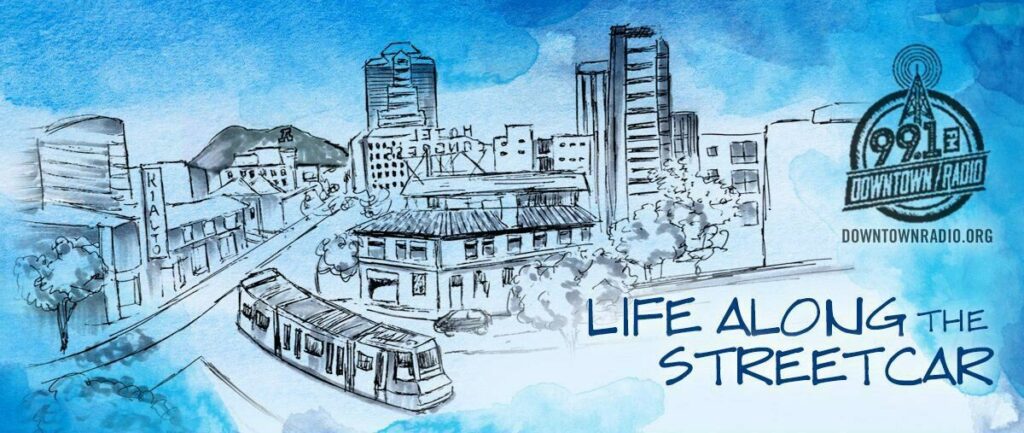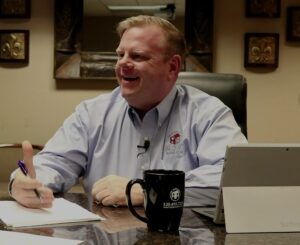Transcript
Tom Heath: Good morning Tucson. It’s a beautiful September Sunday in the Old Pueblo. And I want to thank you for spending a part of your brunch our with us on your downtown Tucson Community sponsored rock and roll radio station. This week, we discussed the host of this show me and my recent appearance on the Creative City Show with Zach Yentzer.
Tom Heath: Each and every Sunday, our focus is on social cultural and economic impacts in Tucson’s Urban core. And we shed light on hidden gems everyone should know about. From A Mountain to the U of A and all stops in between, you get the inside track right here on 99.1 FM streaming on DowntownRadio.org. Also available on your iPhone or Android by using our Downtown Radio app. Just head over to your Google Play or the Apple Store and download Downtown Radio Tucson. If you want to get us on the show, our email address is [email protected]. You can interact with us on Facebook at Life Along the Streetcar and follow us on Twitter at Streetcar Life.
Tom Heath: Today is September 1st. My name is Tom Heath and you’re listening to Life along the Streetcar. And we start the show with some hard labor. Now those responsible for the creation of Labor Day were looking for two things: a means of unifying union workers and a reduction in work time.
Tom Heath: The original Labor Day was actually a walk out and over the early years of this particular, now holiday, it was actually feared that they would be rioting in major cities. Over the time, this day has become a peaceful celebration in a recognition of the labor which powers our industry.
Tom Heath: 12 years after the unofficial beginning of Labor Day, in June of 1894, President Grover Cleveland signed the Labor Day bill into law and it became a U.S. National holiday held in the first Monday every September. September 3rd, 1894 became our country’s first Labor Day. Unlike most U.S. Holidays, there are no recognized rituals. No fireworks. No presents. No colored eggs. We tend to celebrate this day with relaxation, shopping and a little barbecuing.
Tom Heath: For many, this day marks the last weekend of Summer and for some it’s the start of the school year. In 1895 and in Tucson, Labor Day meant something greater and a small article under the city in brief section of the Daily Star, an unnamed journalist penned High Praise for Labor Day.
Tom Heath: The article read that Labor Day is quote, “the one day of the year to which he could look forward and look backward as the goal of a years endeavors and a starting point of a New Year’s work. It’s a day around which all other days revolve. Without the Sabbath, it’s doubtful if the church could be maintained and if there had never been a National Independence Day, this country would perhaps lie in fragments for lack of the cement of patriotism. Let it be observed in Tucson by every laboror, merchants and professional man, a day is little to give to the great cause of Labor”.
Tom Heath: That was from 1895, there in Tucson’s paper. A figure in Arizona and western United States in the labor movement goes under the name of Cesar Chavez. He was controversial for sure. He spent his adult life advocating for the American Farm worker. He is an Arizona. born in he was in San Luis, Arizona and he spent some of his life in California.
Tom Heath: Along with Dolores Huerta, Chavez was one of the best-known leaders of the Hispanic civil rights movement in the 1960s together with her, with a Dolores Huerta, they co-founded United Farm Workers of America. And they fought to end physical and sexual assault of field workers. They emphasized health, issues like access to clean drinking water and limited exposure to pesticides.
Tom Heath: Chavez was not universally loved, but his legacy does endure long after his death which happened in 1993. In 2014, the City of Tucson voted to honor the legacy of this labor advocate with a paid day off for the city employees and that happens in March.
Tom Heath: Now in that session of the city council, then councilwoman and now Democratic nominee for mayor, Regina Romero, said that Chavez was quote “an amazing leader who left a lasting Legacy in my life and the lives of thousands of Working Families in Arizona and across the country. As an American hero and an Arizona native.”
Tom Heath: Chavez himself gave rousing inspirational speeches and in a time when our history was focused on the Civil Rights across the country. It was taking front and center and into speech into Farm Workers says our Chavez said quote make a solemn promise to enjoy our rightful part of the riches of this land to throw off the Yoke of being considered as agricultural implements or slaves. We are free men and we demand Justice. My name is Tom Heath. You’re listening to Life Along the Streetcar on 99.1 FM and available for streaming on Downtown Radio.org.
Tom Heath: We are in the midst of episode 99 here on Life Along the Streetcar and we’ve covered a lot of ground together since we launched in 2017, and there’s lots more to come for sure. But excuse me, if I get a little sentimental about what we’ve accomplished and the the hidden gems we’ve helped to uncover.
Tom Heath: Recently, my friend and fellow radio host Zach Yentzer invited me on his show to talk about the history of our show and I really enjoy talking about how it came to be that Life Along the Streetcar was this weekly look at Hidden gems here in Tucson. And with his permission, I’m sharing a part of the broadcast. The full version of this is available if you would like to tune into his podcast, it’s called the Creative City Show. And here I am with the Zach Yentzer from earlier this week.
Zach Yentzer: 1 2 3 that kicks us off. Good morning again Tucson, welcome, back excited to have to kick our 11 o’clock hour off. I love shooting the breeze with fellow radio people and podcasters and I’ve got a good friend of mine. Who does just that in studio Tommy Tom. Welcome. Well, thanks for having me back. Love being in here. Yeah. This is not the first time you’ve been in here. I think this is your third time in studio.
Zach Yentzer: But you host a show called Life along the streetcar here in Tucson and your focus is the what about the four miles stuff going on along the four miles of the street carb downtown telling those stories of the people and ideas that are working around that area. Correct? Correct?
Tom Heath: Yeah, we focus on a mountain to the U of A. That’s our that is our footprint. It follows try to keep stores geographically within a Mile or so of the streetcar line just simply to create some some boundaries because the we want to have a hyper focus on that area because of what is happening in Tucson.
Zach Yentzer: You kind of wear a few different hats not even to mention the volunteering hat your you are involved in kind of real estate development conversations in the city in a way and tell us a little bit about your on the ground establish your street cred Tom Heath.
Tom Heath: I’ve been in Tucson 25 years and probably last five is when I become very active and realized just as you said earlier that as you claim, you’re not a know-it-all I realized that Not only was I not a know-it-all. I was pretty much a no nothing no nothing and I started digging around and finding all of these things that I didn’t know.
Tom Heath: I didn’t know we have a museum in the middle of downtown Tucson that shoots off a cannon on second Saturdays. I didn’t know some of the history that we had four thousand years worth of History, right underneath the Mercado. I didn’t know about The recreation of agricultural history for four generations at Mission Garden as I started to find these things. I started to look and see what else I did know and how to share that.
Tom Heath: My profession is in the mortgage business. I’ve been doing that for 20 years. So housing for me is a natural concern in a natural fit and is Tucson has been developing there have been concerns by myself and others about the lack of ownership opportunities in the downtown area. So we’ve been exploring ways to help in that regard that takes on a life of its own for sure and you are now um from five years ago being a no nothing as you say to now you help folks who don’t know enough about the downtown area learn more about what’s available and you do that in a couple of different ways.
Zach Yentzer: You kind of launched a new Venture recently that we’ll get to as well, but tell us about that real quick.
Tom Heath: Well, the the reality is I share. Perspective which is the what I’ve learned in the five years and I come at it from I’m not a historian and archaeologist. I there’s people that know so much more about Tucson than I ever will, what I do know is that transition from not understanding to realizing how great Tucson is and that’s that’s that transition that I like to share in the mortgage business.
Tom Heath: I work with a lot of real estate agents their ambassadors to the world. They share Tucson with people from all over the state the country and the rest of the world that want to move here and I found that there was in some cases a lack of understanding of how great Tucson truly is especially in the urban core and with the help of some friends that had similar concerns.
Tom Heath: We put together a tour and for the last eight nine months. We’ve been putting 30 to 40 real estate agents on a on a bus that looks like a trolley taking them around downtown showing them starting at Mission guard and showing them this development all the way through the urban core 4th Avenue main gate talking about the sunshine mile talking about how the push is happening South and we’re seeing Monsoon Chocolate and American eat company and all these fascinating things that are happening and we’ve given them a lot of the developers renderings that have been published so they can see not only what’s here, but what will be on these empty spots and the result has been overwhelmingly positive and been eye-opening for a lot of people that are now starting to see Tucson as I see it.
Zach Yentzer: That’s really cool. And I think what I appreciate about people like Tom, is it often it’s felt like to me over the last few years and this is a feeling I don’t have a data point behind this but it feels like in Tucson you have either the one group that says everything is awesome. We’re going to cheerlead ourselves a success and then you have on almost the opposite end of the spectrum.
Zach Yentzer: The group says no at most things are not awesome. Let’s get our crap together and what I’m trying to carve out And I feel like kind of people like Tom he fit in this is how do we find that middle ground of saying look there’s a lot that is really cool and is really going well and has been and there’s also some gaping holes. So how do we work on the gaping holes while also celebrating what we have going for us and I think that you do that and we get to work on those products together.
Zach Yentzer: That’s why I know that you do that because we get to work on projects that address some of the gaping holes while also saying hey Tucson’s two sons got some really good things going for it. That’s talk about that too. It’s not one or the other.
Tom Heath: I agree that you do have that polarization. I think you’re seeing more people come towards towards the middle and my all a lot of my challenges with some of the the negativity tends to be that it’s information. That’s as you said data points in its statistical, but that’s historical even the most recent data is from 2016 and 2017 one. We’re growing at such a tremendous clip. It’s hard to imagine that in 24 months that the the what we’re seeing now is not what we saw leading up to some of those statistics and it’s hard to balance out what what you see versus what you can prove because what you can prove is two years old sure.
Zach Yentzer: It’s why I’m excited for 2020. We’re going to get a 10 year census done and we’re going to see kind of the real deal because we’re right we’re working off a numbers. It’s now two or three years old. That’s all we have to work with, you know, in terms of data points. Let’s get into Tom. He that’s get into you are the curator of Life Along the Streetcar.
Tom Heath: I like that. I’m a curator. I’ve just gotten a promotion. I like yes. Well, what do you call yourself? I’m just host. I’m just a host. I get to I get to shy get to share other people’s stories. It’s my store is not all that fascinating but I get to share people who are I love that are doing great things.
Zach Yentzer: That’s why your curator curator curator of Life along the streetcar. There’s a couple Stories that you’ve curated time he that I think are interesting to at least kickoff. One is a lot of people don’t know I certainly didn’t know until recently the vast Chinese American history that we have in in Tucson. Am I correct that you got into that recently on the podcast?
Tom Heath: Yeah. It’s one of those areas that I had just some superficial knowledge of and happened to run across some information that led to more conversations that led to meeting the right people. It really started for me. I was doing a story on the Mercado and the four thousand years worth of our archaeological history that’s underneath of it and the going back and reading through like Daily Star back in 2000 and some of those reports and they found a tremendous amount of Chinese artifacts in there and a lot of cookware and others and that’s our leading me down the path of of that’s something we’ve never talked about.
Tom Heath: I start doing some research and it happened to be that a retired Librarian from Community College Sandy Chen was doing a presentation and she was doing it at a former Chinese grocery store. Jerry’s lie. Jerry’s Elijo Market on Meyer and just hearing that fascinating story of four generations of that family managing that space and then that space virtually going into disrepair and almost Vanishing and now it’s being brought back been revitalized and once again is a community center with with opportunity for meetings and others and she held a presentation in there fascinating.
Zach Yentzer: It’s really cool. I can’t remember the number but we talk about density, you know a little bit on this program. There was a density of Chinese American grocery stores in the downtown area. I mean it would it’s more vast than you could ever imagine. Not you Tommy’s but just if you’re listening, we don’t we talk about our you know, Anglo and Hispanic History both separately and then our interactions together. We talked a little bit about our African American history, you know the the Cowboys and we don’t we don’t really talk about our Chinese American history and it was fast really amazing.
Tom Heath: Yeah, it was eye opening for someone who moved here in the 90s and didn’t see really any of that right? You know the like I said, I think there were some where in the neighborhood like a hundred Chinese grocery stores in that general area, right and in the old downtown, right?
Tom Heath: Not the new one the old one might have might have gone, you know little bit farther east, but but not much not much Beyond like country club and then this this understanding of how great of a gardening culture that they had and that they would grow these very wonderful assortment of vegetables and put them on their carts and take them around and you know, just talking to to Sandy Chen, you know asking her kind of why we why it was so prolific and and you know, her thoughts were that it was just it was a niche that they found that they could really serve as a Hispanic community that they felt safe within that community.
Tom Heath: And so you had in Barrio Viejo you had a strong Chinese population and if you can imagine is the picture that she paints is, you know, Chinese grocery store with mariachi music out front. They actually did radio programming out of that store and it was a community center and it was found that 166 hundred South Meyer.
Zach Yentzer: Beautiful speaking of South Meyer. You also interviewed. I think it was both. Jeanann Katina and of the new co-working spaces that there really a neck so that they’re putting down there. Can you speak to that conversation? I mean is body of Viejo is is the neighborhood that was displaced around the TCC that is a hotbed of history and of culture and of culture clash and it’s now being or vitalized quite a bit. You had a very interesting conversation with Gene and Catina about how about the bridge of old and new and what that process looks like a my sort of on track with?
Tom Heath: Yeah. It’s one of those those tangents that that makes life long streak are so fascinating for me is what started as one story led me down to a separate segment on the Chinese American history here and then that led to this conversation about 600 South Meyer and one of the tenants in there is Gina and Katina. I didn’t get a chance to speak with Gina. But Katina Koehler was on the show and the Ashley larussa who manages the spaces was on there with me as well.
Tom Heath: And we talked about what they’re doing and these are entrepreneurial minded individuals that help small businesses and I think large businesses find their way they do a lot with startups and they understand the mentality and the needs of what an entrepreneurial Spirit what they need and how they can drive a community.
Tom Heath: So they found the space. It’s a hundred South Meyer and they open it up really is a way to facilitate their conversations 10 or 15 people at a time. They want to get them in there and have sessions to help them find themselves and grow then they found through the research that couple of blocks north field loss of Crema Tortilla Factory was available and they explored that as a second co-working space that there actually is a co-working space where they could they could put in, you know a more traditional I guess traditional so these days co-working space with desks and and and offices.
Tom Heath: And just around the corner from that a third location, which is what they call Anexo on Simpson that became available as well. So they’ve created this model of really a co-working campus in the in the Barrio Viejo. So there were lots of parameters done. You’re going to have a fairly large meeting space as well as offices. Then you’re going to have an EXO which is sort of in the middle and then you’ve got this facilitation on 600 half my urn and their goal is to utilize what we have in Tucson more abundantly than just about anywhere else which is beautiful weather and using that outdoor idea to to cultivate creativity and put yourself in the right mindset to be Innovative.
Zach Yentzer: Let’s push out our first break just a minute or two because I think if we went to break now we lose the moment. There is a there is a song out of audio Viejo. That was really interesting that you mention. Don’t know if you Get into it, but it’s new to me.
Tom Heath: But what was new to me and you know, I try to end each other’s H show with something. That’s Tucson focused music or Tucson musicians something that’s relevant to the show. And I was trying to find something and because a lot of Guerrero is so heavily mentioned in Barrio Viejo has his face is on the mural of 600 South Meyer and he was brought up in the conversations with say any chance.
Tom Heath: I have to finish a store with a song by LaLa Guerrero and when I was researching and I found one that he sung about Barrio Viejo it’s in 2000, which was just a few years before he passed and it’s on the album. It’s in English and in Spanish. It’s the same song. So I felt it was important and it’s called the old neighborhood and in that he sings about a very romantic song of of where he grew up and knowing his neighbors in a place that was very special to him. But as he was singing that song it it really had become into disrepair and was heading towards what seemed like decay and he sort of finishes up the song with you know, hey Barrio Viejo, we should we should go out of this world together.
Tom Heath: And thinking of that was so powerful to me that this individual at that time in his life. Saw Barrio Viejo the way it was and just as his legacy has lived on and in Tucson and will have an influence in Tucson for so long. I see what’s happening in Bari viejo’s as sort of a rekindling of that spirit and I think now 20 years later if he were to sing that song. I think he would find that romantic Vision coming back because it is it is a place where people know each other people are out walking. They have their families their dogs their their activity. So it’s the song is the old neighborhood Barrio Viejo. It’s on a 2000 album from Lalo Guerrero it’s just a really simple and wonderful song having that.
Tom Heath: That was Zack Yentzer. He’s the host of The Creative City show will link to his podcast from our Facebook page if you want to check him out. He and I sometimes have overlap on guests and I think we share a lot of common themes about the Tucson. So I always enjoy going on and and chatting with him and we’ve had him on ours show probably due to have him back here again and check in with what he is doing. It was very nice of him to give us that spot. It was nice to sort of unwind how we got to episode 99 and looking forward to episode 100.
Tom Heath: Well, my name is Tom Heath and you’re listening to Life along the streetcar on Downtown Radio 99.1 FM and available for streaming on Downtown Radio dot. Well, hope you enjoyed episode 99. I got a chance to talk about the meaning of Labor Day and how How we looked at it in 1895 and how we looked at it today and also a little little history there of Cesar Chavez and his impact on the labor movement Across the Western United States including Arizona and right here in Tucson.
Tom Heath: Now, in researching that that story we did find that the statue of Cesar Chavez, which has been talked about for some time heading into 525 points are it looks like that’s going to happen this year. So if when that does we’ll we’ll head back down and do a story and feature that part of some of the renovations happening at our Southern Gateway right there in the in Five Points next to Cesar Chavez park.
Tom Heath: On today’s show, we also had a chance to revisit my appearance with Zach Yentzer on his podcast the Creative City and I really appreciated the opportunity to share how we got Life Along the Streetcar going, why we’re sharing this information and then the fun part was sort of going back through three recent episodes and realizing that there was no plan to this.
Tom Heath: We just started talking to people and it led to a different. topic so we just kept following that path and ended up with three really good shows and that’s going to carry on into September as we focus on Lala Guerrero who came up and and one of those shows so we’ll do a feature with him and his impact on on the music scene, but also in the community here in Tucson.
Tom Heath: And also in September we’re going to have Mayor Rothchild on, he is ending his term as mayor of Tucson and he’s got some big plans in the works to say involved and be a part of the young entrepreneurial Drive here in Tucson. So we’re going to sit down with him talk about his time in office and kind of what he plans to do when he gets a little more time on his hands and then next week episode 100.
Tom Heath: We decided it’s gonna be fun to bring in John Shuster. The Shoe hosts a show here on Downtown Radio called the Shuniverse, but his background is as a writer for Tucson Weekly for for many years, so I thought it’d be fun to sit down with him and talk about What he’s seeing he hasn’t been writing for the weekly lately. So maybe he’s a little Freer to speak his mind. I don’t know. It’ll be a fun little interview.
Tom Heath: That’ll be next Sunday with John Shuster right here on 99.1 FM, and we’re going to leave you today with a little music seems to be a very appropriate title for for me. It’s called a happy Fool by Tom Walbank, and I hope you do enjoy this little Blues tune. My name is Tom Heath and you’re listening to Life Along the Streetcar. I do. Hope you have a great Labor Day weekend and tune in next week for more of our uncovering of those hidden gems. Have a great week everyone.




